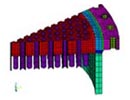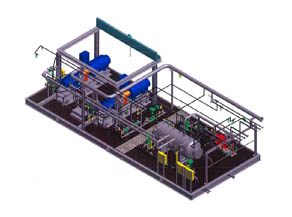History of Finite Element Analysis
Keywords: Rayleigh Ritz Method; Triangular Stress Elements; Nastran; Product Design
Although there ids no definitive date when Finite Element Analysis (FEA) was first developed, the generally accepted beginning of FEA occurred in the late 1800’s, when John William Strutt Rayleigh developed a method for predicting the first natural frequency of simple structures. He did this by assuming a deformed shape for a structure, then quantified the shape by minimizing the distributed energy in the structure. Walter Ritz then expanded this into a method – now known as the Rayleigh-Ritz method, for predicting the displacement and stress on structures.
The choice of assumed shape was critical to the accuracy of the results and boundary conditions. Unfortunately, the method proved to be too difficult for complex shapes because the number of possible shapes increased exponentially as complexity increased. This predictive method was critical in the development of FEA algorithms in later years.
Advancements in Numerical Methods and Computing
By the 1940’s, numerical methods had been developed to predict behavior of more general structures. These were frame and truss based – from Hrenikoff, and later utilized energy methods from Alberto Castigliano and William Rowan Hamilton. In 1943, Richard Courant proposed breaking a continuous system into triangular segments. Other authors in the field included Argyris,(6), Turner et al.,(7) and Clough (8-10).
The Development of Finite Element Analysis
The 1940s also saw the “birth” of digital computing with the unveiling of ENIAC at the University of Pennsylvania. This room-sized computer was commissioned by the U.S. Army to calculate ballistic trajectories during WWII. The computer used electromechanical devices for data storage and vacuum tubes for calculations, and required a team of operators to keep it running at a maximum processor speed of 46 operations per second.
By the 1950s, analog computers had been developed to process more complex structural problems. With the promise of more powerful computers, analytical methods were advanced to include matrix based solutions of frame and truss structures.
Introduction of Triangular Stress Elements and Finite Element Terminology
The next significant step was taken by Boeing in the 1950’s when they used triangular stress elements to model airplane wings. The benefit to the growing aerospace business was clear – and most major aerospace manufacturers were developing in-house programs for structural analysis on computers.
The basic concept of finite elements was thus born, although the process was still time consuming and limited. In 1960, Dr. Ray Clough coined the term “finite element” after he (and others) had published the first article on the technology in 1956 in Journal of Aeronautical Sciences – entitled “Stiffness and Deflection Analysis of Complex Structures.”
Commercialization and Expansion of FEA
The 1960s saw the true beginning of commercial FEA as digital computers replaced analog ones with the capability of thousands of operations per second. However, most codes were still industry, company, and even product specific. Zienkiewicz and Cheung (4) wrote the first book devoted to the finite element method in 1967.
In the early 1960s, a small analog computer manufacturer for the aerospace industry was awarded a contract from NASA to develop a general purpose FEA code. This company, The MacNeal-Schwendler Corporation (MSC), ensured the growth of commercial FEA by developing what is now known as NASTRAN.
This original code had a limit of 68,000 degrees of freedom, which was believed to be larger than anyone would need. When the NASA contract was complete, MSC continued development of its software, called MSC/NASTRAN, while the original NASTRAN became available to the public. About the same time period, other software packages were being developed – including ANSYS, MARC and SAP. However, computing power at this time was quite limited.
The Impact of Graphics Processing and Advancements in Product Design
By the 1970s, minicomputers were developed, and were more powerful than earlier mainframes. However, developing solutions to complicated problems was still too resource intensive for more casual users despite the enhancements in hardware. In the 1980’s, developments in graphics processing left their mark on FEA as graphical `pre’ and `post’ processors became available and engineers could examine colored stress contours instead of studying tabular output. Thanks to this advancement, design engineers began to seriously consider incorporating FEA into the general product design process.
Applications & Advancements
Finite Element Analysis has revolutionized engineering design & analysis, enabling engineers to optimize structures, predict failure points, and reduce development costs. It has found applications including aerospace engineering, automotive design, civil engineering, and material science.
Over the years, researchers have developed various numerical techniques to enhance the accuracy, efficiency, and robustness of Finite Element Analysis. These techniques include adaptive mesh refinement, higher-order element formulations, multi-scale analysis, and parallel computing, among others.
Conclusion
The history of Finite Element Analysis showcases a remarkable journey of innovation and collaboration, driven by the relentless pursuit of understanding complex systems. Over the years, FEA has transformed engineering and scientific disciplines, driving advancements across numerous industries. As technology continues to evolve, we can expect Finite Element Analysis to remain an indispensable tool for simulating, analyzing, and optimizing intricate systems in the future.
References
1) Vince Adams & Abraham Askenazi “Building Better Products with Finite Element Analysis” OnWord Press, Santa Fe, NM, 1999
2) J.N. Reddy, “Introduction to the Finite Element Method” 2nd Ed., 1993, McGraw Hill
3) Saeed Moaveni, “Finite Element Analysis – Theory and Application with ANSYS” 1999, Prentice Hall
4) Y. K. Cheung and O.C. Zienkiewicz “The Finite Element Method in Structural and Continuum Mechanics” First Ed., 1967 McGraw Hill
5) R. Courant, “Variational Methods for the Solution of Problems of Equilibrium and Vibrations’, Trans. Amer. Math. Soc. 1-23 (1942)
6) J. H. Argyris, “Energy Theorems and Structural Analysis, Part l”, Aircraft Eng., 26, 383 (1954)
7) M. J. Turner, R. W. Clough, H. C. Martin and L. T. Topp, “Stiffness and deflection analysis of complex structures”, J. Aeronaut. Sci., 25, 805-823 (1956)
8) R. W. Clough, “Original Formulation of the Finite Element Method”, Proc. ASCE Structures Congress Session on Computer Utilization in Structural Eng., San Francisco, May 1989, pp. 1-10.
9) R. W. Clough, “The Finite Element Method, in Plane Stress Analysis”, Proc. 2nd A.S.C.E. Conf: on Electronic Comp., Pittsburgh, PA 1960
10) R. W. Clough and E. W. Wilson, “Stress Analysis of a Gravity Dam by the Finite Element Method”, Proc. Symp. on the use of Computers in Civil Eng. Lab., Nacional de Engenharia Civil, Lisbon, Portugal, 1962
See Also (Blog) Finite Element Analysis for the Non-Engineer.
O’Donnell Consulting Engineers Performs Finite Element Analysis of Various Components to API, ASME and other Codes.

For a client that manufactures components for Formula One Race cars, we performed engineering analysis and design optimization on Brake Rotor Designs.



